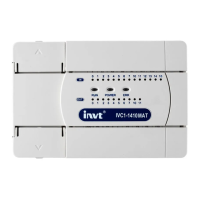Goodrive35 Series Closed-loop Vector Control VFD Communication protocol
216
Chapter 10 Communication protocol
10.1 What this chapter contains
This chapter describes the communication protocol of Goodrive35 series VFDs.
The Goodrive35 series VFDs provide RS485 communication interface. It adopts international
standard ModBus communication protocol to perform master-slave communication. The user can
realize centralized control through PC/PLC, upper control PC, etc. (set the control command, running
frequency of the VFD, modify relevant function codes, monitor and control the operating state and
fault information of the VFD and so on) to adapt specific application requirements.
10.2 Brief instruction to Modbus protocol
Modbus is a software protocol, a common language used in electronic controllers. By using this
protocol, a controller can communicate with other devices through transmission lines. It is a general
industrial standard. With this standard, control devices produced by different manufacturers can be
connected to form an industrial network and be monitored in a centralized way.
The Modbus protocol provides two transmission modes, namely American Standard Code for
Information Interchange (ASCII) and remote terminal units (RTU). On one Modbus network, all the
device transmission modes, baud rates, data bits, check bits, end bits, and other basic parameters
must be set consistently.
A Modbus network is a control network with one master and multiple slaves, that is, on one Modbus
network, there is only one device serving as the master, and other devices are the slaves. The master
can communicate with one slave or broadcast messages to all the slaves. For separate access
commands, a slave needs to return a response. For broadcasted information, slaves do not need to
return responses.
10.3 Application of the VFD
The Modbus protocol of the VFD is RTU mode and the physical layer is RS485.
10.3.1 RS485
The interface of RS485 works on semiduplex and its data signal applies differential transmission
which is called balance transmission, too. It uses twisted pairs, one of which is defined as A (+) and
the other is defined as B (-). Generally, if the positive electrical level between sending drive A and B is
among +2–+6 V, it is logic"1", if the electrical level is among -2 V–-6 V, it is logic"0".
485+ on the terminal board corresponds to A and 485- to B.
Communication baud rate means the binary bit number in one second. The unit is bit/s (bps). Higher the
baud rate is, quicker the transmission speed is, and weaker the anti-interference is. If twisted pair of
0.56mm (24AWG) is used as communication cable, the max transmission distance is as below:
Max transmission
distance
Max transmission
distance
